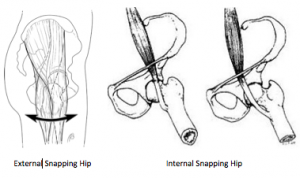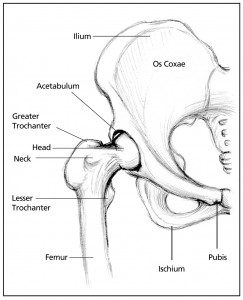 Snapping hip syndrome refers to strange sounds, sometimes painful but often not, that emanate from the hip and pelvis.
Snapping hip syndrome refers to strange sounds, sometimes painful but often not, that emanate from the hip and pelvis.
The popping, if it is on the outer hip, results from a tendon getting stuck temporarily as it crosses the greater trochanter—a small knob of bone on the outside of the femur, or leg, bone.
On the inside is the lesser trochanter that the psoas major and iliacus muscles attach to via their common tendon.
When snapping hip syndrome is felt on the inside of the leg it involves the iliopsoas getting caught around the femur head and the pelvis.
The sound or sensation that we refer to as snapping hip syndrome happens most often due to tight muscles, misaligned bones or a combination of both.
Tight muscles will have trouble making their way freely around the inner or outer leg and misaligned bones place a greater burden on muscles by altering their natural movement patterns.
The IT band, a thick band of connective tissue on the outside of the thigh attaches from the rim of the pelvis to the tibia of the lower leg.
When this is tight due to either poor posture or poor mechanics it often gets stuck on the greater trochanter as the leg moves through a particular motion.
My take on pelvic alignment is that most people don’t have their leg bones well connected into the pelvis.
There is a ball at the top of the femur bone that sits into a cup, the acetabulum, in the hip.
When the pelvis is in correct alignment the lesser and greater trochanters are better situated for movement.
The lesser trochanter (iliopsoas popping) aligns in the back plane of the body when correctly situated.
When the pelvis tucks under and the lesser trochanter is forced forward (this goes for the greater trochanter as well which is turned towards the back) the likelihood of snapping hip syndrome increases exponentially.
So many strange aches pains and occurrences in the body happen do to basic postural imbalances.
For whatever reason, many people turn to posture and movement as a means to ease pain as a last resort. We would be well served to take a different approach from the start.

